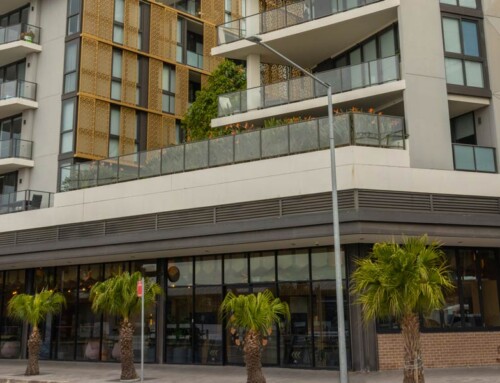Making an Educated Commitment to Sustainability

“I never want a student to have to study to find a way to undo what we did to their planet.”
That statement, spoken by George Bernardon, vice president of grounds management for SSC Services for Education, during the company’s 50th-anniversary celebration in September of 2019, helped strengthen the building services contractor’s commitment to sustainability. SSC, a Knoxville, Tennessee-based company that provides facility management and cleaning for more than 170 educational clients in 27 states, has grown its sustainability program through employee passion, according to Catherine Merritt, director of communications for SSC.
“Maybe it is the nature of working in the education environment that fosters a natural desire for betterment or the education environment that draws to it people who already have this innate desire, but we are all the better for the culture that empowers our environments to thrive,” Merritt claims.
From classroom cleaning to groundskeeping and facility maintenance, SSC works with its clients to prioritize tools and techniques that protect human health and the environment.
“SSC does not sell environmental sustainability as an add-on or an afterthought,” Merritt says. “Environmental sustainability is a lifelong course we find embedded across all of the micro-cultures within SSC’s accounts, and every step forward one campus makes, is shared and integrated into our collective.”
Conserve precious resources
SSC’s mission is to manage award-winning campus landscapes while preserving the environment. Its grounds management programsare bu ilt around protecting local watersheds, reducing reliance on synthetic fertilizers and pesticides, and building a culture of doing the right thing, not only for today, but long term.
Water conservation is always top of mind in SSC’s facility management operations. Water-use reduction can be as simple as planting native species or as complex as installing a smart irrigation system, reveals Brandon Haley, SSC’s senior project manager for sustainability and grounds. Available features on smart irrigation systems include weather- and soil-based controls, as well as components focused on water application and flow sensors that support automatic leak shutdown with alerts.
“And then there is everything in-between: rainwater harvesting, bioswales, xeriscaping, rain gardens,” Haley continues. “Our water conservation programs save millions of gallons of water every month while still allowing the landscape to look and perform its best. It is quite common for a well-run water conservation program to save over 30% of outdoor water usage, with opportunities for conservation goals to reach over 50%.”
Energy-conserving tactics include switching from gas-operated to battery-operated landscaping equipment. “Electric equipment is rapidly becoming our standard and is less of a sustainability practice, but a part of our normal operations. Electric handhelds are more accessible than ever as we see battery lives extended and the benefits of reduced maintenance and ease of use,” Haley says. “We also have a fleet of electric mowers, each with over seven hours of continuous mowing time. The reduction of noise pollution that goes along with them is amazing.”
According to David Payne, vice president of facilities and energy services at SSC, one simple way to conserve water and energy in facility maintenance is to verify all equipment is operating according to its engineering design specifications.
“Operating equipment outside its design parameters leads to less efficient operation,” says Payne. “A good example is a water-cooling tower for a chilled water system. Improper operation may not only lead to excessive electrical usage, but excess water waste caused by unnecessary water loss through evaporation and blowdown, as well as other costs associated with transporting the water to the site and chemicals for water treatment.”
Payne recommends establishing a preventative maintenance (PM) program that ensures energy systems are properly managed. Facilities also need to continually look for opportunities for energy conservation improvement, such as through the implementation of new technology.
Don’t skimp on preventative maintenance
Paul Tisch, regional director of operations for building maintenance at SSC, builds on the emphasis of a strong PM program. “Replacing belts in air handler units, properly greasing and checking AMP draw on motors, and replacing air filters before becoming clogged will mitigate wasteful energy consumption,” he says.
Maintenance workers under Tisch regularly assess aging equipment, replacing it with more energy-efficient alternatives. This practice includes upgrading lighting systems with less energy-consuming LED lamps.
The workers also practice water conservation as part of the PM plan. “Repairing or replacing leaking pump seals, leaking faucets, and running toilets when needed is only the beginning,” Tisch discloses.
Routine inspections of water-consuming systems such as boilers and cooling towers are part of a maintenance plan. Utilizing technology and water treatment chemicals allows a system to minimize water usage in both steam-generating boilers and cooling towers. For instance, adjusting the cycles of chemical concentration has resulted in a more than 20% reduction in cooling towers’ water consumption, according to Tisch.
He explains that creating deferred maintenance (DM) initiatives that are focused on conserving energy will result in cost savings that can help fund the project and reduce its budgetary impact for years to come. For instance, in two years, the Jasper County School District in Ridgeland, South Carolina, which includes multiple facilities for pre-K to 12th-grade schools, saved more than US$900,000 in electricity and water consumption at its facilities as the result of a DM energy project created to improve the quality of the facilities, followed by a PM plan that will keep the equipment running at optimal efficiency for years to come.
Payne explains that it is standard SSC practice to operate equipment within its designed operational parameters and to execute a strong PM program at all client facilities. “Too many facilities deprioritize PM only to see their corrective maintenance (CM) skyrocket. This misalignment of priorities costs campuses significantly more in the long term, not only financially, but in environmental impact through energy consumption and landfill buildup,” he says. “SSC fully utilizes a CMMS [computerized maintenance management system] to not only schedule and track completion of work, but also to track the equipment performance history over time.”
Measure your environmental footprint
Schools that are just beginning their sustainability efforts should start by determining how much energy they are actually using and whether their utility bills are correct. “Using the parallelism ‘you can’t manage what you don’t measure,’ many schools just pay the utility bill without understanding the details of how the energy is charged from tariffs and fees,” Payne reveals, giving an example of an SSC client that was being overcharged more than $180,000 due to a misplaced decimal point in a utility bill. “It is understandable that a school would not have the technical resources to read and fully understand the bill in the accounting office, but it is beneficial to have the support of a facility partner to review and ensure the billing is correct,” Payne says.
Another good first step toward sustainability is performing an engineering energy survey of your facilities. Payne explains that an energy audit is a process and inspection survey to understand the building’s energy use and to identify opportunities to improve energy efficiency while maintaining or improving occupants’ comfort.
In addition, you need to understand your facilities’ energy use intensity (EUI). The EUI is an indicator of the energy efficiency of a building’s design and/or operations. It can be thought of as the miles-per-gallon rating of the building industry.
Although you’ll want to focus on the obvious energy-consuming sources, such as building equipment and systems, when setting sustainability goals, don’t overlook the effects of routine groundskeeping tasks on the environment. “The nitrogen that greens our grass, the salt that prevents icy falls, or the pesticides that keep away a destructive species—if not properly controlled—can cause greater harm to our water system that dramatically outweighs the good it did for our campus,” Haley says.
School campuses draw numerous, long-term benefits from an integrated pest management program, irrigation assessment and monitoring, and landfill diversion practices. “You cannot have a strong plant without strong soil, and using organic fertilizer helps us do that,” Haley adds. “This means we get the added soil health benefits, have less reliance on mined or petroleum-based fertilizers, and send less waste to landfills.”
Educate for community buy-in
A critical component of a sustainability program’s success is community buy-in. SSC develops programs to engage students and teach them about the environmental practices on campus. For instance, SSC workers create edible gardens on school grounds to demonstrate how spaces for growing food can be integrated into landscapes.
“Sustainability is not just about reducing our impact on the environment,” admits Haley. “It is about preparing the next generation to do even more than we can imagine.”
Even if you fear your facility is lacking in environmentally conscious, tree-hugger types, Merritt believes that everyone has something they care about that can be improved upon through energy conservation and sustainability.
“Someone may not care about optimized cycles in a cooling tower, but they will get behind a plan to install more native pollinators so they can enjoy the butterflies. They may not care about increased carbon emissions from an ancient HVAC system, but they do care that their office is the right temperature when they arrive each morning,” Merritt says. “Make sure people see a ‘why’ that matters to them [in your facility’s actions to embrace sustainability].”


















